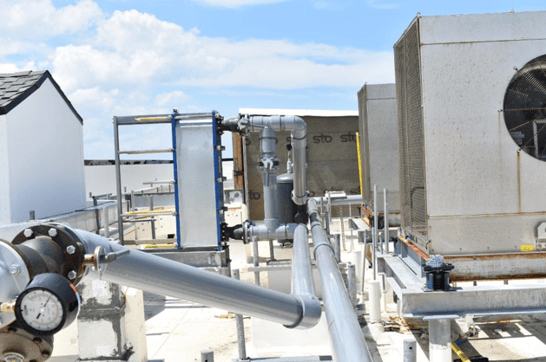FlowGuard® CPVC Offers Significant Value in HVAC Piping Projects
When a building is heated and cooled by means of the forced circulation of hot water, chilled water and/or steam, that HVAC system is referred to as “hydronic.” Hot water and steam are generated with boilers, and chilled water with chillers.
Across the world, the pipe and fittings for this complex equipment, including condensate drain piping, can be made of FlowGuard® CPVC because it fully conforms to the requirements of the International Mechanical Code and Uniform Mechanical Code. Engineers and plumbers can be confident that FlowGuard CPVC will perform as expected in hydronic applications, provided the piping is rated for the operating temperature range and pressure of the system to withstand the internal stresses placed on it over time.

CPVC Delivers Incomparable System Design and Water Quality Benefits
Being code compliant is just one reason why specifiers and installers can trust FlowGuard CPVC. Of particular note: engineers can design for optimum flow with lightweight HVAC pipe without compensating for friction loss from metallic corrosion and scale buildup. Since FlowGuard CPVC is non-metallic, it will never pit, scale or corrode. Hydraulic calculations for sizing pipe and fittings should simply incorporate a Hazen-Williams C factor of 150, which will remain constant as the system ages because of minimal pressure drops from friction, and save up to 70% in pumping power over the life of the system.

Just as importantly, FlowGuard CPVC’s smooth, nonporous internal pipe surface carries the lowest potential for the biofilm growth that can lead to Legionella, and to withstand the ASHRAE 188 Guideline disinfection procedures that dictate very high temperatures and/or highly chlorinated water.
Legionella, the bacterium that causes the serious lung infection Legionnaires’ disease, is generally present in local water sources in benign amounts. But these microbes are capable of colonizing in warm water environments, including cooling towers for HVAC systems. Cooling towers can be particular problem instigators when water system maintenance has been subpar, Legionella has already colonized, and the outdoor air intakes are located downwind of the towers. That aerosolized water vapor then becomes the carrier of disease through widespread inhalation by occupants of buildings like hotels and hospitals.
Other singular advantages to CPVC include:
- Plumbers trained in this material find that it installs quickly and easily, and that dependable joint strength can be achieved through solvent cement welding.
- Installed costs are favorable vs. steel, and can be reduced as much as 25% for material and 35% for labor.
- Suitable fire caulks, lubricants and other ancillary products are easy to find thanks to Lubrizol’s FBCTM System Compatible Program, which verifies the chemical compatibility of FlowGuard CPVC with ancillary products that adhere to certain quality standards.
While refrigerant and/or compressor lubricant should not normally enter the recirculating fluid in a properly operating system, they may be released into the recirculating fluid and/or condensate drain in the event of a rupture of the heat exchanger. Polyol ester (POE) lubricants are incompatible with CPVC and will likely cause cracking of the fittings and/or pipe if they are released into the recirculating fluid or condensate drain. Lubrizol is not aware of any failures of HVAC piping systems that have been caused by other types of compressor lubricants including mineral oils, polyvinyl ethers (PVE), polyalkylene glycols (PAG) or poly-alpha-olefins (PAO).
When planning for CPVC in an HVAC application, please contact one of our FlowGuard CPVC piping system consultants for guidance in achieving a quality installation.
.png)
-1.png)
